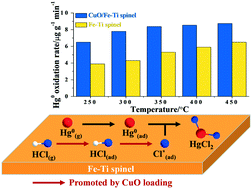Conversion of gaseous Hg0 to soluble Hg2+ using selective catalytic reduction (SCR) catalysts with gaseous HCl as an oxidant as a co-benefit of NO abatement is widely used for resolving Hg pollution from coal-burning power plants. Nevertheless, the performances of conventional V2O5–WO3/TiO2 for NO abatement and Hg0 oxidation are unsatisfactory. In this study, CuO/Fe–Ti spinel was exploited as a novel and high-activity catalyst for the simultaneous removal of NO and Hg0. The outstanding SCR activity and high N2 selectivity of Fe–Ti spinel did not distinctly decrease after CuO loading; thus, CuO/Fe–Ti spinel achieved efficient NO reduction. Although Hg0 physical adsorption onto Fe–Ti spinel was slightly suppressed after CuO loading, the Cl* radical formation was appreciably promoted as both HCl adsorption and the conversion of adsorbed Cl− to Cl* radicals were promoted. Hence, the Hg0 oxidation activity of Fe–Ti spinel was appreciably improved after CuO loading, and the rate of Hg0 oxidation for CuO/Fe–Ti spinel reached approximately 6.8–8.7 μg g−1 min−1, which was better than those of most other SCR catalysts. In summary, CuO/Fe–Ti spinel shows great promise as an SCR catalyst for Hg0 oxidation as a co-benefit of NO abatement from coal-burning flue gas (CFG).
